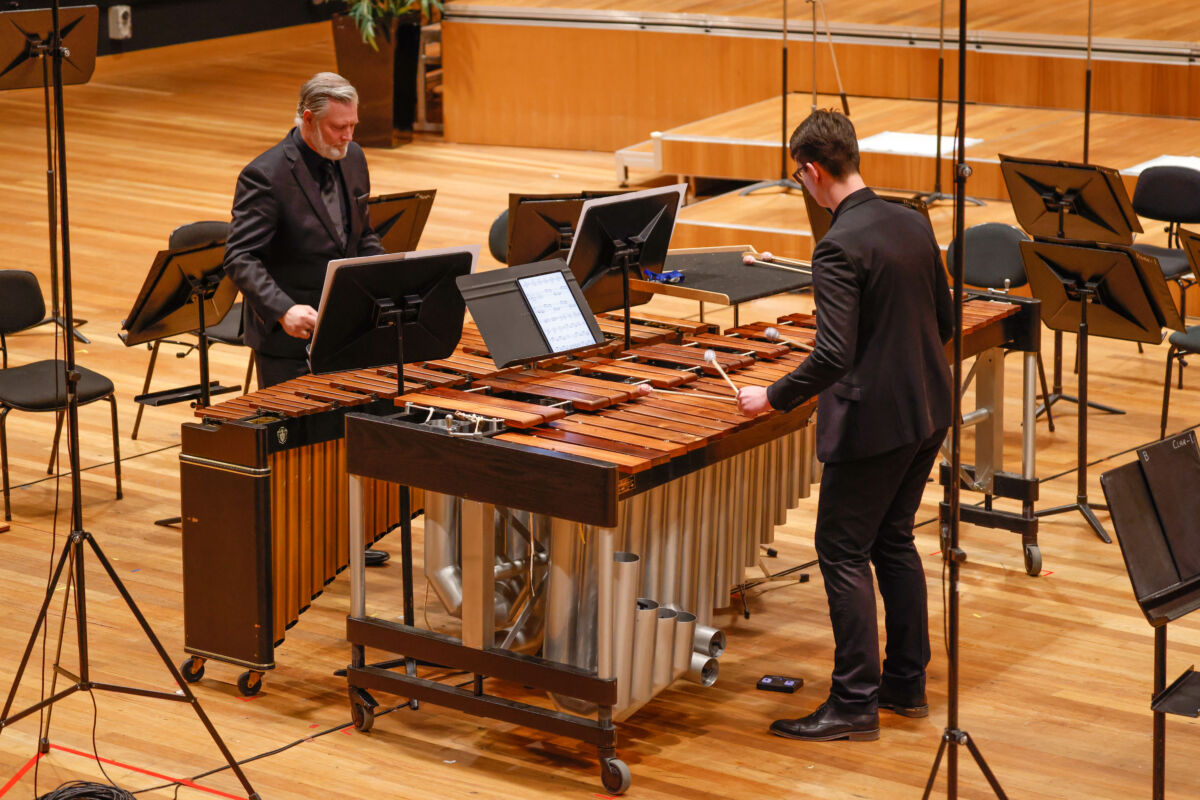Studio Sessions 1 (Queensland Symphony Orchestra)
The Queensland Symphony Orchestra Studio sessions the series is all about the players. Instead of full-scale orchestral masterpieces, we have unusual chamber repertoire (some composed by the performers!) and a decidedly more laid-back atmosphere. the Studio sessions are a great idea, adding to the character of the orchestra as a whole, but allowing the audience to see the musicians in a more intimate setting.
David Montgomery and Jacob Enoka perform at the Queensland Symphony Orchestra’s Studio Sessions 1 concert, March 2022. Image © Peter Wallis.
While Studio Sessions 1 might not have the most exciting name, the repertoire is interesting. Here the emphasis is on brass and percussion, with works for brass quintet (trumpets, horn, trombone and tuba) and several percussionists, who are rarely seen in small chamber groups.
The performance began with Callum Kennedy’s Perseverance for brass quintet (Rainer Saville and Richard Madden on trumpet, Lauren Manuel on horn, Ashley Carter on trombone and Thomas Allely on tuba). In a separate interview with QSO, Kennedy had previously noted the influence of the music of Nobuo Uematsu, composer of the early Final Fantasy games, on some of his music. This influence was definitely felt, with triumphant Eumatsu ping-pong melodies from trumpet to trumpet, with a funny bass backing it up. I wish some sections had been a little longer – once or twice I wanted some of the juiciest harmonies to go a little longer, but it was a good start to the performance nonetheless.
For the next piece, it turned out that David Montgomery, main percussionist of the QSO section, is also a composer. Sleepless groundfor two percussionists, was a meditative set of variations on a Bach G Goldberg Variationsand Montgomery and Jacob Enoka impressed here. Sleepless ground began with Enoka steadily repeating a simple rhythmic pattern while Montgomery’s part grew increasingly complex, before Enoka’s part evolved alongside it to result in a rich rhythmic tapestry.
The brass quintet is back for Michael Tilson Thomas street song. Although he’s probably best known as a bandleader, Tilson Thomas’ musical language reminded me of Copland, but with a sensible dose of added dissonance – Copland on acid, perhaps. Although each musician played well (I loved the smoky richness of the ensemble’s tone in the later jazzy sections), a few slight slips in the ensemble’s cohesion served as a reminder that (as Montgomery later noted ), the musicians had not been able to rehearse until the previous week, due to the recent Brisbane floods. Good, but not as accurate as it could have been.
At Bela Bartok 6 dances to the Bulgarian rhythm of his Mikrokosmos are favorites of pianists for good reason. Audiences are very used to hearing everything carefully enunciated in 4/4 blocks of time, with an occasional 3/4 when things get really crazy, but these Bulgarian-inspired works shed those expectations of conventional rhythms – the first of the set, for example, opens with rolling groups of 4, 2 and 3 beats. The arrangement of these by section lead percussionist David Montgomery for three percussionists (with Mary Broughton joining Montgomery and Enoka on stage) was the highlight of the concert, Montgomery’s added parts nicely fleshing out the original rhythms. The twist here is that, after each piece, Montgomery responded to Bartók’s originals with his pun. 6 bulges in the dancerian rhythm, which were great and exciting pieces that responded to and built on every Bartók piece we had just heard. Surely these need registration?
Finally, Marc Satterwhite And what a brute beast…? for tuba and percussion closed the concert. Satterwhite could be director of the Grassemeyer Prize for Music Composition, but I can’t help but think that his writing here really clouded Allely’s playing by combining Allely’s powerful low range with Montgomery’s low toms – a combination that essentially canceled each other out to be little almost inaudible. Maybe it was just the acoustics of space itself, but half the time I could only hear Allely’s high-pitched trills. The end of the track (in which the stage lights are turned off and all the other musicians rush onto the stage to make as much drumming noise as possible) was a bit flat too – lots of sound, yes, but without having heard a much of the overpowering intensity of the tuba in earlier sections, it felt rather undeserved.
Still, an unusual set of pieces, and it’s definitely something I like to see. Not a completely successful concert, but certainly interesting.
QSOs Studio sessions will take place throughout 2022. Visit the website for more information.



Comments are closed.